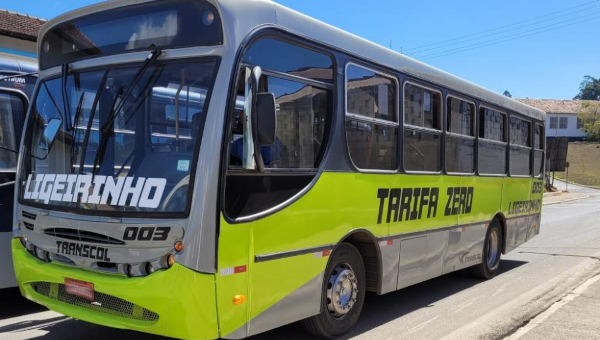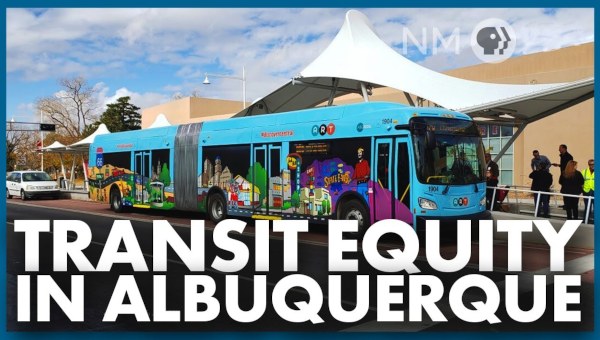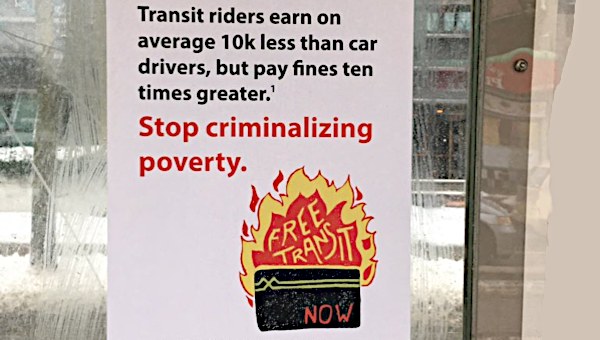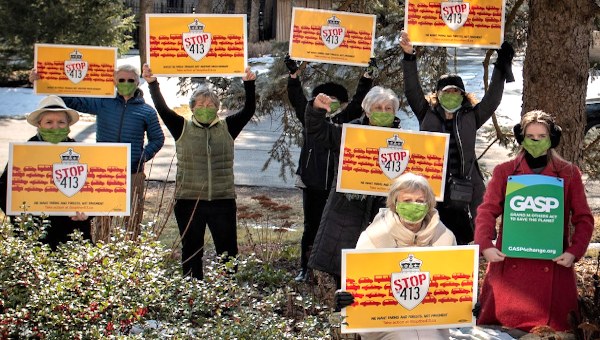A Complete Turnaround of the Transport Sector is Absolutely Imperative
In order to fight climate change the whole system of transportation has to be reversed and reconstructed as it is currently responsible for one fifth (in some countries up to one quarter) of the production of greenhouse gases. From 1970 to 2004 the oil-based transportation sector (cars, SUVs, trucks, ships, aircraft) increased its CO2-emissions 222%. Predictions indicate by 2030 it will increase another 80%.
Between 2015-19 at least 90 million vehicles were produced annually. Yet the individual vehicle sits idle 90% of the time, necessitating the construction of parking spaces and garages. These vehicles create 78% of the CO2-emissions caused by the construction, maintenance and use of streets and highways (the rest comes from buses, trams and trains). Further, this mode of individual transportation is market driven and therefore reinforces inequality. We can no longer afford the ‘car culture’ that has dominated society over the last 75 years.
Despite the need to substantially reduce the traffic and storage of the individual motor car, converting the auto industry into one that produces for mass transit will be a difficult struggle. Nonetheless we have a partial model: during World War II all US auto production was halted as Washington requisitioned the plants for wartime production. An even more wide-reaching industrial conversion is necessary today with the necessity of drastically reducing our dependence on fossil fuels.
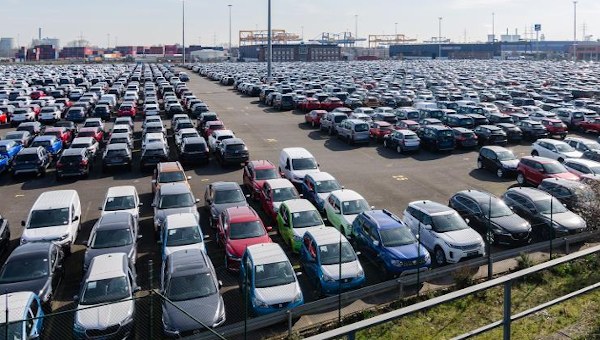
Central Driver of Industrialization
Further, auto accidents are a major problem. According to the World Health Organization, 1.35 million die from auto accidents each year while 50 million suffer non-fatal injuries. Approximately seven million die from air pollution, perhaps one million or so from vehicle fossil fuel emission or their maintenance.
The car industry has been a central driver of industrialization over the last century. The industry depends on a downriver network that drills or fracks for oil and mines for minerals. These are transformed into chemicals, tires, glass, steel, plastic and then shipped to assembly plants. It creates an upriver market of showrooms, repair shops, gas stations and junk yards. In analyzing how the drive for profitability is bound up in the need to expand production, we recognize that we must do much more than decarbonize our world. We also need to evaluate and reallocate the other natural resources that go into its manufacturing processes. Given that private ownership and the profitability it generates got us into this crisis, the business elite are clearly incapable of managing the turnaround.
Insofar as they recognize the seriousness of the crisis, these capitalists have responded by offering electric vehicles as the solution. While this does reduce the use of fossil fuel in the gas tank, it doesn’t deal with the totality of the vehicle’s life span. Instead we propose worker-community teams that can manage an efficient transport system available to all.
E-Cars Constitute No Solution for the Existing Ecological Problems
Mainstream media, parts of the bourgeoisie and large parts of the general public consider the switch to electric vehicles a solution to the problems produced by greenhouse gas in the transport sector. But there are fundamental reasons why this does not work and why this may even add to the ecological problems we already have:
- Before they are even driven, the electrical vehicle brings along an enormous “ecological backpack”: The production of the batteries demands high levels of energy consumption and an extensive use of raw materials so that you have to drive an electric car for 8 years before there can be a cutback of CO2-production as compared to a fuel-driven car.1
- Even these 8 years of achieving a cutback of CO2e-output would only be valid if the electrical energy to be consumed were 100% ecological, which is completely illusory. The existing electricity mix (mainly coal, gas, oil, regenerative resources) will not be substantially changed in the coming years. So, if a considerable number of e-cars (even disregarding e-trucks and e-buses with batteries) were to be used, more carbon-based electricity (fossil fuel) would have to be produced. Furthermore, an enormous amount of new infrastructure would be needed (millions of charging stations etc. which require a lot of additional CO2e-production) as well as continued maintenance of highways and roads as part of the infrastructure (in the United States, 2014 the average cost of reconstructing an existing lane of a major urban freeway was $7.7-million per mile and on a collector street in a small urban area it would be $1.5-million).
- There are important rebound effects:
- The use of e-cars would produce more traffic, as people think this is an ecological vehicle (because it does not burn fuel). All the more so, because such a car is substantially more expensive and people may think they have to use it more frequently in order to make it “ecologically effective.” At the same time those people would use public transport less frequently.
- Because of the small range of those cars (around 200 km, only the big Tesla reaches 400 km, in winter all those figures are even more modest) and because you need several hours for recharging the battery, 59 % of the e-cars are second cars. These additional cars add to the general disadvantages of what you can call the “car society.”
- And there is a rebound-effect already visible today: E-cars will prolong the increasing production of SUVs.
Apart from the fact that all the other disadvantages of the car-based transport system (see below) would persist, there are some additional ecological disadvantages of which one should be aware and that are completely denied by the supporters and users of e-cars:
- Important raw materials would be massively exploited. You need four times as much copper for an e-car (up to 80 kg per car). By 2027 the excavation of copper will increase tenfold (the main countries concerned are Brazil, Peru, Chile and Argentina.
- The production of the batteries demands the processing of vast amounts of very precious raw materials: lithium, graphite, cobalt and nickel. Today’s production of lithium amounts to 200,000 tons, by 2025 this will increase to 600,000 tons. Tesla engineers project a need of 2 – 3 million tons.2 One ton of lithium demands the use of 1.9 million liters of water.
- Number one of the main contributors to the production of greenhouse gas in the transport sector is motorized private transport. But other contributors are very harmful as well: the shipping of containers around the world, cruise ships and aviation, the latter for instance being three times more harmful than the use of a car and 19 times more harmful than the use of a train (measured in passenger kilometers). Not only cars used by individuals are devastatingly detrimental, the increasing use of trucks (while dismantling the railways) for the carriage of freight is appalling and not only on an ecological level.
Furthermore, changing the transport sector is not only urgent because of ecological reasons.
Why Motorized Private Transport is Deadly, Even Disregarding the Ecological Effects
1. Above all we must be aware of the fact that this type of transport system causes a very high death toll. In the EU alone 25,000 people died from car accidents in 2018, 135,000 were badly injured. Figures of Road Safety Report 2018 (figures for 2016) published by the WHO indicate that in the USA more than 39,000 people died, in India more than 299,000 and on the world level 1,323,666 (these are only the officially registered deaths). This high death toll is only to be explained by the high danger of what can be called “the car-society,” i.e. motorized private transport and the excessive use of trucks, aircraft and container shipping. In order to get the proportions right, we might take the example of Japan in the years 1966-1975: At that time there were 190 deaths caused by train accidents but 46,486 deaths caused by car accidents, although those trains transported more people than those who travelled by car during this period. That equates to 1: 245.3 Since the invention of the car the death toll has amounted to more than 48 Million which is equivalent to a world war.
2. In addition: The long-term effects of noxious substances emitted by cars and trucks must not be forgotten. Particularly devastating are particulates (to a large extent caused by emissions from cars and trucks, mainly from tires and brakes) and NOx. In most of the big cities the boundary value defined by the WHO is largely exceeded.4 In Shanghai till the end of the 20th century doctors had to operate on 1000 lung cancers per year. 15 Years later numbers grew to more than 10,000. The WHO figured that on the world level about 4.5 million people die every year of particulates (to a large extent due to street traffic).
And there is another factor that affects our health: The use of cars and air traffic is an important factor for the increasing noise that provokes considerable numbers of heart attacks, sleeplessness, high blood pressure, nervous breakdowns and other serious diseases.5
3. Priorities of investment and infrastructure are given to those sectors where capital can realize a maximum of profits, which ‒ for the transport sector ‒ concerns not only the construction of highways but of all of our towns and cities. The structure of cities has been completely deformed, making them suitable for cars, not for pedestrians or cyclists. This obstructs public transport and makes the cities not only unhealthy but also places in which one does not really want to live or pass one’s free time. Urbanity is largely compromised which makes the fight for the “right to the city” (Lefebvre) all the more urgent.
At the same time the car-centered transport system affects the infrastructure also on a regional, national and international level. Almost every journey (every locomotion) is getting longer. In the 1970s a Western European completed motorized every day journeys of about 9,000 km per year. In 2006 this amounted already to 14,000 km. Essentially this is not due to more travelling but to the longer distances to the workplace, to go shopping and so on.
The urban planner Martin Wagner (exiled to the US) compared Berlin at the end of the 1920s with New York 1957. The results of those studies are quite clear: The number of journeys (i.e. any locomotion) a person has to (or wants) to complete during one year has not considerably changed within these years. They amounted to roughly 1,000 per year and 650 of those could be within walking distance, if…, if the urban planning were made meeting ecological and social criteria. Recent German statistics counted an average number of journeys of 1216 per year. The increase is mainly due to the discovery of new journeys such as accompanying small children, which would ‒ to a large extent ‒ not be necessary, if the distances for the children were short enough, i.e. were as short as they were one hundred years ago and if rational urban planning were implemented.
4. The car-society is also very space-consuming, above all for the use of the domestic vehicles since they need eight times as much space for transport as the one needed for a train-based system (measured in passenger kilometers). Compared to cars the tram needs 40 times less space. On short distances trucks need 15 times as much space as trains, for smaller lorries (and shorter distances) the proportion is 70:1.
The space consuming effect is true on two more levels: First there is the endlessly ongoing highway construction, the building of car parks, requiring more and more land where raw materials are extracted etc. The second additional level: The Worldwatch Institute (Washington) discovered that the production of ethanol needs an enormous amount of land: For a car which runs on ethanol, agricultural land is needed that is 16.5 times larger than a small farmer needs to produce the goods for his living during one year. Today almost 900 million people are starving while every year 142 million tons of cereals and canola are transformed into “biofuel,” enough to feed 420 million people. Since a growing amount of arable land is being transformed into areas for planting “crops for the tank” these areas are lacking for the production of food. Not to be forgotten: Depending on the region up to 3,500 liters of water are needed in order to produce one liter of “biofuel.”
5. Because of the uninterrupted growth of the “car-society” not only have journeys (the average locomotion) got longer, people also have to spend more and more time in travelling, most of all on the way to the workplace. In the cities ‒ from Mexico-City to Peking, from LA to New Delhi ‒ people spend hours in the daily congestion. Already in 1998 German statistics counted 67 hours of congestion per year for people in the cars (that is more time than they spend making love). In 2018 the average time consumed by congestion amounted to 120 hours per year and driver.6
Furthermore, the number of cars will increase worldwide. In 2010 we had one billion cars; in April 2019 1.24 billion; by 2025 recent studies expect 1.8 billion and by 2050: 2.7 billion (that is 2700 million!). Including trucks, buses and so on we will have 2.1 billion vehicles on the roads in 2025, which is the double of those in 2010.7 Add to this the fact that the cars produced and used(!) are equipped with steadily more horse power. In 2017 in the US 11 million SUV were sold, not including the growing number (and growing horsepower) of pickups.
Taken all this together we are confronted with climate collapse unless we enforce a thorough reversal of the philosophy of the whole transport sector.
6. The “car-society” is expensive.
Buying and maintaining a car is much more expensive than the use of a rational public transport sector. Separate from the ecological and other above-mentioned effects, every car is highly subsidized by society (that is by the taxpayer).
Although the widely used term “external costs” is in fact misleading (since these costs are not coming from the outside and are structurally inherent to the car-based transport system) the results of different studies are quite clear and reasonably allied. The most important one is the research “External Effects of Transport. Accident, Environment and Congestion Costs of Transport in Western Europe”. In the study of 2004, the figures are given for the year 2000. According to that these costs amounted in the then EU-15 together with Norway and Switzerland (we call it EU-17) to 7.3% of its GDP, without counting the costs of congestion. The shares that counted most were the effects on climate (30% of the “external costs”) and the effect on healthcare mainly in hospitals (24%).
In the meantime ‒ with cars, especially SUVs, getting bigger all the time, road building getting more expensive ‒ we are now seeing up to 10 % of GDP for the costs that are allegedly “external,” all the more so if we account for congestion costs and the rising costs for the greater infrastructure needed for the trucks (such as the “gigaliners” etc.).
This corresponds to the research made at the university of Dresden, that (in Germany) every car is subsidized by 2,000 Euros every year. This amounts to 45,000 Euros of subsidies for a car by society. Other studies estimate even higher figures such as those of IWW/INFRAS. For 1996 this institution calculated already yearly subsidies of 4,000 DM (= €2,250) for every car8 every year! In fact, only a small part of the population would be able to add €25,000 to the price they pay for a new car. So, the existing system is a huge subsidizing system for the whole of the oil-based economy, above all the car industry.
Capitalism Cannot Solve the Problems
The existing social and political system is dominated by a majority of powerful fossil companies, that have lots of capital invested in this particular part of the economy which makes it an oil-based economy. For decades already among the ten biggest trusts in the world five to seven have been “fossil” (the following ranking is that of 2017 when again seven have been “fossil”): Royal Sinopec (in the oil sector, No. 3 of the ten biggest companies); China National Petroleum (oil; No. 4); Shell (oil, No. 5); Toyota (car industry; No 6); Volkswagen (car ind.; No 7); BP (oil; No 8); Exxon (oil; No. 9).
This mighty sector of the capitalist economy is at the same time the impulse generator of capitalist development: Since the reestablishment of a “normal” cycle of capitalist development (in the middle of the 1970s) we had five cycles and those were always at the same time the cycles of the car industry (at this moment we are at the end of cycle 6). Most importantly, new production and transportation methods since the 1970s have built a global supply chain that employs trucks, planes, rail and ships to cut production costs. These various forms of transit transfer standardized containers from one part of the world to another. This space-shrinking technology is built on lowering tariff barriers and improved communication. Technology allows for the coordination of a globally dispersed set of activities, permitting an increasing division of labor. It begins with sourcing raw materials but assigns material assembly and component production to the lower-wage areas, while also imposing strict standards (a process known as fissuring). Management also emphasizes lean production and just-in-time delivery to drastically reduce the need for inventory. Although the logistics of the global supply chain differ by industry, in auto it has resulted in an 11% reduction of the total cost in the OECD countries alone. However some corporations are rethinking globalization given the disruption that the COVID-19 virus has caused.
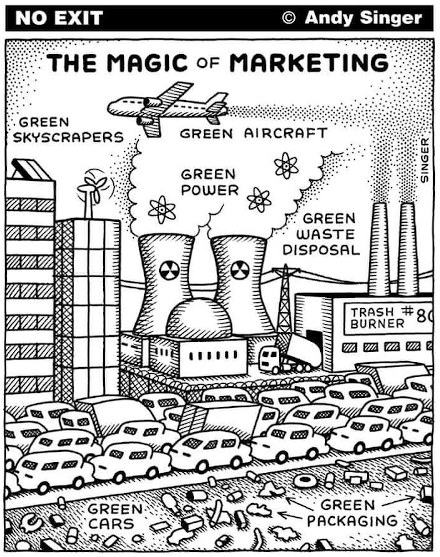
The range of the oil-based economy (the fossil economy) goes far beyond the car industry: the shipping sector, aviation (air traffic) and of course the energy sector (electricity, heating). The whole infrastructure of the economy and our way of life (ranging from the way our cities are built to the entire transport sector) are determined by the fossil sector of economy.
Turning away from this type of economic functioning will not be made possible by strong arguments alone. A majority of the population will have to be convinced that we need a complete turnaround if we, our children and grandchildren, are to have a future worth living. Broad coalitions of ecological and social forces will have to fight the interests of those companies. That ‒ by the nature of all the implications ‒ means that this fight will have to be linked up with fighting for a different type of economic and social system. For that turnaround a total reversal of all investments will be needed. Only society as a whole will be able to afford and execute it. Expropriating capital will be a precondition but by itself will not be enough. This is similar to what is true for the liberation of women, oppressed nationalities and so on: Without abolishing the car-society socialism will not be possible and abolishing car-society will not be possible without socialism.
Key to the transformation of the auto industry into a mass transportation system is the workforce and the larger community at every stage of the process of extraction, production, transportation and maintenance. That is a network of worker-community organizations will need to analyze, plan and construct the new system. These committees will also implement the working conditions with attention to worker and community compensation and safety This will include reducing and equalizing work hours, maximizing the ability of all to participate in planning and reconfiguring jobs to spread knowledge and satisfaction. Paid time off would be guaranteed for a broad range of needs. The differential between the Global North and South would be ended and other forms of discrimination eliminated by the democratic participation of all. Of course, there will be mistakes, but these can be corrected through the transparent processes of democratic analysis, evaluation and decision making.
What Are Our Objectives?
By putting forward our demands we don’t appeal to governments (or to the ruling class as a whole as a matter of fact) but we clearly spell out the changes we think are necessary to fight for. This fight has to be staged from below by all the dominated classes.
Our demands, our short-term and long-term objectives are:
- Massive upgrading of the public transport systems with emphasis on reintroducing, building and massively expanding the tram-based transport sector and ‒ where feasible ‒ the reintroduction and spreading of trolleybuses.
- Convert the car industry into building public transport vehicles (trains, trams, trolley buses etc…).
- Make all public transport in the cities and surroundings free for the users.
- Restructure the cities, so that most destinations (workplace, shopping…) will be within walking distance.
- Along with the implementation of these measures, ban the car from the cities (except for emergency services).
- Tax air transportation adequately, so that aviation will drop by at least 70 to 80%. Ban all aviation under the distance of 1000 km.
- Suppress the world-wide supply chain for industry to a large extent so that container shipping will be cut to a tiny dimension.
In the fight for a different transport system, the conversion of the automotive industry is absolutely key. Since the production and operation of public transport (bus, train, etc.) is far from achieving profits comparable to the mass production of cars, it will never be possible to persuade the affected capital owners to make such a conversion. Thus, the struggle for a compensation-free expropriation and socialization of those means of production is the great challenge in the fight against climate change and for a social and healthier transport system. •
This article first published on the Fourth International website.
Endnotes
- To produce one kilowatt hour of storage capacity of the batter you have to produce 150 -200 kilo CO2-eqivalents (CO2e). For the production of the batteries for a small e-car you have to produce 6 tons of CO2e, for a Tesla S (85 kwh) this amounts to 17 tons of CO2e. In order to have an idea of those proportions: An average citizen in Germany has an CO2e-output of 8,9 tons (in Austria 6,9 tons, USA 15 tons) per year.
- To get an idea of the proportions: For a smartphone you need 3 grams, for a laptop 50 grams, for a Tesla e-car: 50 kg.
- The Economist, 31-8-1985.
- The threshold value for particulates defined by the WHO is 45μg/m3 on 35 days per year.
- The threshold values defined by the EU: 45 – 50 dB(A) for the night and 55 – 60 dB(A) for daytime are exceeded in many cities especially those near an airport.
- In Berlin: 154 hours, in Munich: 140 hours. The costs were calculated by different researchers: €80,000-million for Germany alone.
- The maximum number of e-cars is expected to reach 150 million, which means that the increase of number of fuel cars will be more important than that of e-cars.
- In Germany (1996) car owners paid 63,7 billion DM taxes but at the same time society spent 301 billion DM for the car part of the existing transport system.


